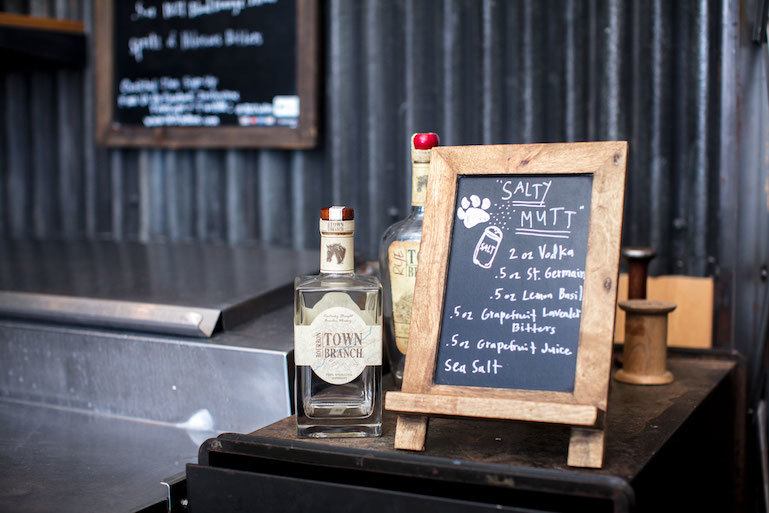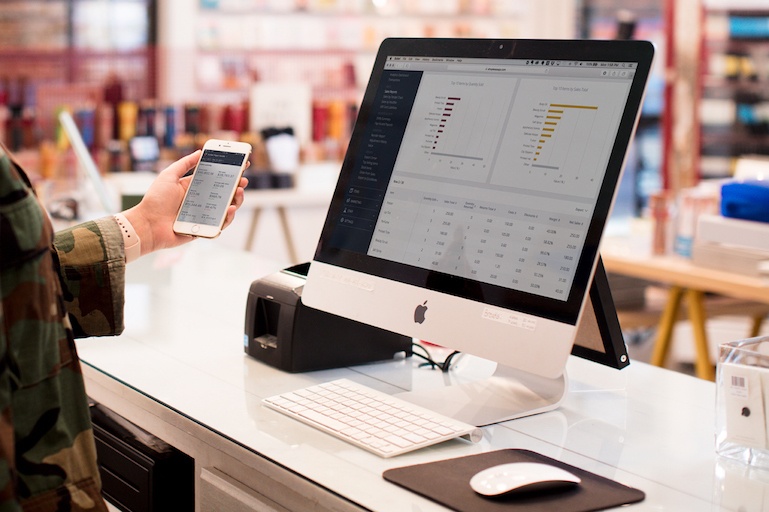
How to Take Liquor Inventory For Your Bar
Running a bar is all drinks and laughs with customers, right? Wrong. In this post, we’ll help you work through a common challenge by showing you how to take liquor inventory in the most efficient way possible.
Inventory is the largest single asset on the balance sheet of many businesses. It is typically the most costly asset to own and maintain. That’s why proper inventory management is vital for your business to succeed. Unless you keep accurate track of all the goods in your inventory, you’re likely to lose money.
Inventories are made up of many different components, depending on the business. For a bar that could include raw ingredients, packaged drinks, custom cocktails, food, and even some retail products like t-shirts.
To run an organized and profitable business, it’s crucial to keep proper records of your inventory to ensure that no malicious activities are taking place (like theft) and that you have the items you need in stock. Typically, businesses should reconcile inventory weekly, bi-weekly or monthly, and bar inventory is no exception to this rule.
What Is Bar Inventory?
The inventory in your bar includes the whole list of liquor and other stocked products you serve to your customers. This would consist of any beer, sodas, juices, wine or other beverages that are listed on your menu.
SEE ALSO: The Only Bar Equipment List You’ll Ever Need
Why Is Bar Inventory Important?
Inventory is the driving force of your bar, and poor inventory management can be disastrous. With too little stock, your bar will lose out on sales and tarnish its reputation. On the other hand, excess inventory requires costly additional storage space. Excess stock also encourages and increases the risk of waste.
How to Manage Bar Inventory
As with any other industry, bar inventory management is difficult. You need to take into account various factors that may be behind any discrepancies when reconciling these types of inventories. Frequent spillage, breakage, theft, and free drinks can affect your profit margins.
It’s essential for a bar to tally up the accounts every day to ensure that inventories are correct, and proper measures must be followed to have a perfect statement of items on hand for proper planning and to prevent inventory shrinkage.
If you’re in the market for a bar inventory system to get better control of your stock, it’s best to begin by understanding why you require a bar inventory system. There are many bar systems out there, and they all vary in the ways they perform, but in the end, the best bar inventory software is the one that best fits the needs of your bar and the objectives you are looking to attain.
Key Questions to Consider
Before setting up a formal process or buying any specific bar inventory management tools, you’ll want to answer some basic questions:
- How often do you plan to take a complete bar inventory?
- Are you taking a stock audit to keep your staff members accountable on a daily, weekly or per shift basis?
- If you take a monthly inventory of beer, liquor and wine, what do you intend to do with the gathered information?
- Can you afford a bar inventory system from a budgetary perspective, and do you have the internal resources to maintain it?
Establishing a bar inventory system requires many changes, particularly if you’ve been tracking inventory by hand. You must realize early on that setting up a formal system for managing liquor, beer and wine inventory is not a one-and-done task. It must become long term, ongoing and a constant part of the business’s management for it to be successful.
If you’re going the software route, be diligent when choosing an inventory software system, because setting one up can be a lengthy process. You want to pick the right tool the first time around. Lastly, it can have an extremely positive impact on your company bottom line, but that only happens if you actually use the tool. So get one you can see yourself using on a day-to-day basis.
With the above in mind, let’s look at the two main ways that most bar owners take bar inventory:
- Manual inventory control
- Automated Bar Inventory system

Manual Inventory Control
This involves manually counting your inventory regularly (monthly at a minimum) to reconcile every item and catch any discrepancies, including both simple human errors as well as theft. The physical stock count is done with the help of spreadsheets. Even if they choose to go with an automated inventory system, many bars still count your inventory manually every month, so it’s worth understanding this method.
Doing so will give you a deeper understanding of the basics of bar inventory, which will help you make better purchasing decisions. Hand-counting can be a tedious and time-consuming process, but it’s crucial to ensure that your profits are not ending up in someone else’s pockets.
The manual count entails a complete account of all the liquor, beer, wine, and other beverages or other ingredients behind the bar, in the cooler, and the stockroom. Your goal here is to reconcile your inventory on hand against the invoices you have to pay.
A Step-By-Step Guide to Counting Inventory Manually
For this method, you will need spreadsheets or worksheets to take inventory counts. Make sure the spreadsheets are organized in a way that’s suitable for your bar.
-
- Organize the spreadsheet the same way your liquor is arranged on the bar. This will save you a lot of time and work rearranging bottles.
- Start at the shelves at the front of the bar. Count the bottles the way they are positioned and fill in the spreadsheet. Ensure that you have a column for alcohol type, brand, name and bottle size. Also include a column for your back bar, storeroom, walk-in cooler or any other parts of the bar where alcohol is kept.
- If you have half-full bottles, the simplest and most common counting method used is to visually take note of how much liquid is in each bottle and record in tenths. If the bottle is half full, it is recorded as 0.5, if a third full record as 0.3, etc.
- Repeat the “tenthing” process for every half-filled bottle, and input the numbers onto the spreadsheet as either wine, beer or spirit.
- Repeat this entire counting process in the back bar, walk-in cooler and storage room. Here your count is likely to vary; you will have figures that include a mixture of bottles and cases, instead of bottles only, so you need to add another column to your worksheet to account for this.
- To finish, take your worksheet and add up the totals for each category.
At the end of the inventory period, whether it’s after a week, two weeks, or a month, you need to count the inventory once again and repeat the same procedure. This will leave you with a starting inventory count as well as an ending inventory count.
Throughout the given period, you will receive more items and sell others. Keep a record of all the items you will receive (this should be in your invoices), and the items you sell should be recorded in your POS system.
In a new spreadsheet, input the totals of all your alcohol categories into three columns:
- Starting inventory
- Received inventory
- Ending inventory
Then use this simple formula to know your inventory usage for a given period: starting inventory + received inventory – ending inventory = usage.
With the inventory usage, you will be able to tell how your bar is performing financially, which products are selling well and which don’t, what your pour cost should be for each product and where your shrinkage is coming from.
SEE ALSO: Insider Secret: How to Control Inventory in a Small Business
General Guidelines for Manual Inventory Counting
Keep the following tips and best practices in mind when developing your own manual inventory management process.
- Considering have a separate worksheet for each product category. Include every type of product you have. Classifications always help.
- It is not just the quantity that matters. You also need to have the price included to ensure you have a thorough inventory management system.
- Your bar inventory list should contain the alcohol brand, the purchase and sale price per bottle and the stock availability of each product.
- Start your day by counting your inventory. Do not forget to include all that is in and out of storage.
- Every single bottle should be accounted for, so you have to instruct your staff to save the empty bottles for counting. This also significantly helps you plan your orders for specific liquors.
- Broken bottles should be included in inventories, so you should have your staff maintain records of all broken bottles.
- Check the closing stock for the day and tally it with the sales for the day. Do not forget to include broken bottles and wastages.
- To ensure that there are no errors, it is suggested to instruct all managers to maintain a proper record. Provide them access to your worksheets so that they can list the details concerning the purchase and sale of drinks, liquor bottles, food, etc.
- Get all the staff members involved in the manual bar inventory counting process. Periodically have two individuals take stock separately, then compare their results. This can help prevent clerical errors.
- If you find that a particular item is not being used, look for means to incorporate it into popular drinks. Make use of ingredients that may otherwise go to waste, which will help control costs and enhance profitability.
- Be sure to count inventory during non-working hours so that you are not distracted. Distractions while counting can cause errors and large amounts of wasted time.
An Automated Bar Inventory Management System
Manual counting is a complex process, which can be laborious and take up too much time. A computerized system is a better way to take liquor inventory. It will do most of the work, and help you count, manage and value your stock in an all-in-one platform. That means it can connect with your bookkeeping, purchases and set your price points accurately.
Moreover, it will help keep your customers coming back because when there is not enough inventory, customers may decide to go to a different bar. When there is a surplus of one item, inventory gets tied up in unsalable goods. A properly designed bar software spontaneously updates stock levels whenever sales are made and helps in the entire bar inventory management process.
Before buying a bar inventory system make sure that it includes all the best features so that you get a system that makes running your bar more of a pleasure than a chore. Here are some important features you want it to include.
Useful features for bar owners and managers include:
- The inventory software should let you centrally manage common aspects of your business like prices, happy hour promotions, menu items, marketing, and many other parts of the business.
- The standard management reports produced can highlight best-selling products, slow sellers, busy times and profit margins.
- Employee performance reports made by the inventory software should show the number of customers served and the average time for each food ticket.
- Creation of recipes or cocktails based on the current cost of all menu items.
- The software should support loyalty tools for easy creation of loyalty programs, reward vouchers and membership schemes. Also, membership cards should self-top up and deplete at the point of purchase.
Features that help staff better perform their jobs:
- Large, bright graphical touch screen layouts that display both images and text.
- Easy to use screen layouts that let staff input and modify orders quickly.
- Unique logins for each staff member.
- The ability to send drink orders direct from the bar POS terminal to a separate kitchen printer.
- Printing individual shift reports by cash drawer at the till.
- Automatic recognition of customer membership, printing discount or gift vouchers at the till.
- SMS or email messaging directly from the POS terminal.
- Robust, reliable hardware, better system redundancy, and tools for securing customer data.
ShopKeep has developed a tablet-based point of sale system that features a fully integrated inventory management system that gives you instant, real-time counts of inventory as it is being sold. The bar POS system offered by ShopKeep effectively tracks your inventory, letting you know how much of each item should be on the shelf at any one time. You can check your inventory whenever you like, either at the start of a shift, or at the middle or end. Your stock is monitored constantly.
This inventory management software can help your bar, pub or night club in a variety of different ways, such as increasing revenues, make better purchasing decisions and saving time. It is also more practical and efficient than the manual tracking method. Using the ShopKeep bar POS system for liquor management is an excellent choice for the vast majority of bar owners.

Here are a few benefits of using a bar inventory management software.
Make Better Buying Decisions
With the ability to quickly access data like inventory levels, product performance and profit margins, it’s possible to make the best buying decision for increased sales and profits. Also, you can make immediate changes to information stored in any shop register connected to the software.
Real-Time Inventory
Most inventory management tools seamlessly link with other systems in your business, making it easy to update inventory data continually. With easy access to revenue and profit reports the bar owner or manager can easily make purchases due to the improved supply chain visibility and more efficient operations.
Streamlined Inventory
Tracking stock is highly versatile because the software has the option of connecting with a wide variety of devices, such as iPads, bar-code scanners, smartphones and tablets. Also, a business with two or more outlets is often able to track all sites using one central dashboard.
Instant Data
This gives you the option to quickly see the volume of stock that is either waiting to be stocked or already on store shelves. With immediate access to all stock, it’s much simpler to make strategic decisions that relate to item pricing and purchases, as well as producing promotions and special deals.
Recognize Shrinkage
It is possible to minimize the time and effort invested in searching for lost or mislaid stock. Also, it helps to track stock that goes missing when you least expect, which might be a sign of employee theft.
Integrate With Other Systems
A further benefit of this type of software is the ability to integrate with accounting, marketing, or other small business tools. This makes managing your day-to-day operations more efficient because many common tasks can be handled from one tool.
Finally, opt for a software vendor that is reputable in the industry and has an excellent track record for customer care, automated software upgrades and technical support. Remember the bar business is fragile, and if the inventory is not managed correctly, the business may not run smoothly. Finding, installing and making use of the best inventory software is critical for your bar because it gives you optimal control over your inventory. This will not only enable you to control costs, but it will also help you save money by keeping wastage in check.
Want to try ShopKeep for yourself?
Just answer a few easy questions.
Need help finding the right point of sale?
Just complete the form. We’ll call you right back to explain how ShopKeep can work for you.
Hit the ground running.Sprinting, in fact!
Read our free, comprehensive guide, Small Business 101, to learn all you need to know about starting a thriving business.

